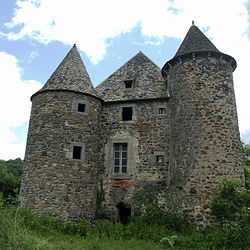Carlat
| Carlat | ||
|---|---|---|
 | ||
| ||
 Carlat | ||
|
Location within Auvergne region  Carlat | ||
| Coordinates: 44°53′25″N 2°34′03″E / 44.8903°N 2.5675°ECoordinates: 44°53′25″N 2°34′03″E / 44.8903°N 2.5675°E | ||
| Country | France | |
| Region | Auvergne | |
| Department | Cantal | |
| Arrondissement | Aurillac | |
| Canton | Vic-sur-Cère | |
| Government | ||
| • Mayor (2008–2014) | Alain Cousin | |
| Area | ||
| • Land1 | 20.88 km2 (8.06 sq mi) | |
| Population (2008) | ||
| • Population2 | 288 | |
| • Population2 Density | 14/km2 (36/sq mi) | |
| INSEE/Postal code | 15028 / 15130 | |
| Elevation | 480–906 m (1,575–2,972 ft) | |
|
1 French Land Register data, which excludes lakes, ponds, glaciers > 1 km² (0.386 sq mi or 247 acres) and river estuaries. 2 Population without double counting: residents of multiple communes (e.g., students and military personnel) only counted once. | ||
Carlat is a commune in the Cantal department in south-central France.
The "Rocher de Carlat" or rock of Carlat situated above the picturesque commune was once the site of one of the most powerful and impenetrable chateaux in all of France. It was the seat of Jacques d'Armagnac, Duke of Nemours, duke of Nemours, and often the center of intrigue, resistance and rebellion against the kings of France. Completely razed by order of the king in 1604 to alleviate the inconvenience of rebellious and ambitious southern relatives, hardly a trace of the chateau remains. The site is now a park, open to visitors and commanding sweeping views of the Carlades.
The chateau appears in history as early as the year 839. The presence of Queen Margot, Marguerite de Valois, who sought refuge at Carlat from 30 September 1585 to 15 October 1586, lives on in local lore. Given the site's historic importance as a major fortress of Auvergne, a substantial archeological program is underway to rediscover its treasures.
Population
| Historical population | ||
|---|---|---|
| Year | Pop. | ±% |
| 1962 | 356 | — |
| 1968 | 432 | +21.3% |
| 1975 | 394 | −8.8% |
| 1982 | 364 | −7.6% |
| 1990 | 306 | −15.9% |
| 1999 | 305 | −0.3% |
| 2008 | 288 | −5.6% |
See also
References
External links
| Wikimedia Commons has media related to Carlat. |
